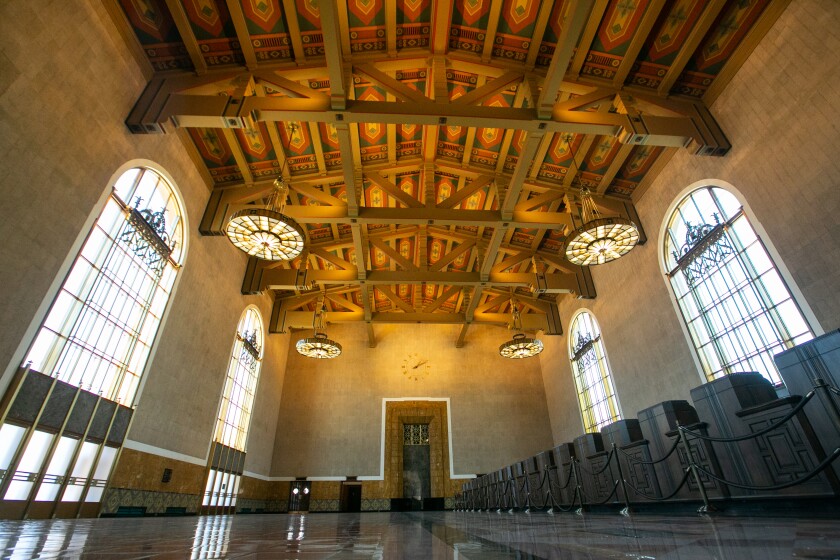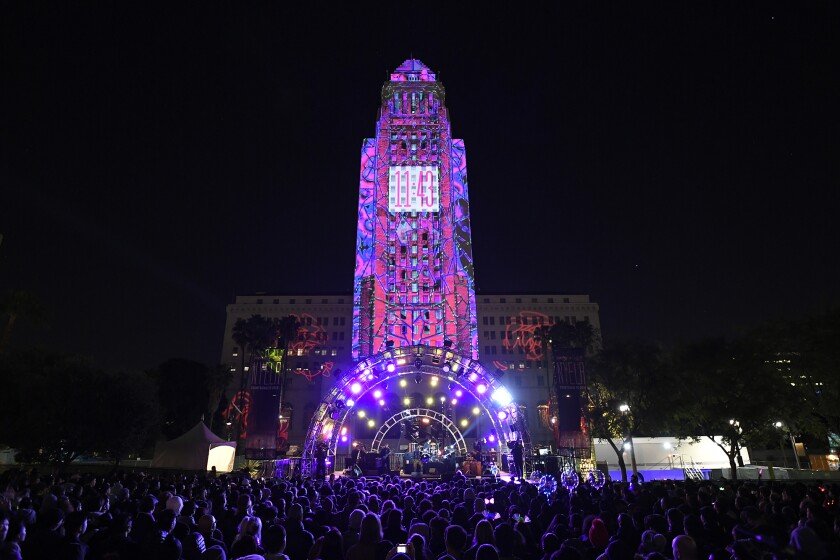When the Academy of Motion Picture Arts and Sciences announced this year’s Oscar nominees on March 15, it also let drop that it was mixing things up on the venue front: Instead of staging the entire 93rd Academy Awards ceremony at the Dolby Theatre on Hollywood Boulevard, nominees, presenters and their guests will attend a more intimate — and socially distanced — supper club-style event at Union Station in downtown Los Angeles on April 25. The 3,400-seat Dolby Theatre, located inside the Hollywood & Highland shopping mall, which has hosted the Oscars since 2002, will instead be used to broadcast additional show elements. All that florid interpretive dance has to go somewhere.
And so does L.A. traffic. Which brings me to the first question raised by the move: What will the Academy Awards — known for establishing a Baghdad-like green zone around the perimeter of Hollywood & Highland in the days and weeks prior to the ceremony — do to L.A.'s most important public transit hub? Union Station, after all, is where Amtrak, MetroLink, the Gold, Red and Purple Lines meet, along with a plethora of bus lines, including Greyhound, Megabus, LAX Flyaway, not to mention the untold number of local buses that connect downtown with the rest of the city. Places like Union Station are how working people — the ones who can’t Zoom it in during a pandemic — get to their jobs.

The historic ticket concourse at Union Station will serve as a site for the 93rd Academy Awards.
(Jason Armond / Los Angeles Times)
A press release issued by Metro at the time of the announcements states that the agency will be “working hard to minimize disruptions around Union Station” and that no “bus or rail closures due to the event” are expected. But as urbanism writer Alissa Walker notes in a story in Curbed, “Anyone who has been there during a film shoot, navigating closed-off entrances and heavily patrolled detours, knows, it will end up negatively impacting people who rely on transit.”
She suggests holding the ceremony at Dodger Stadium. I have a better idea: Stage it at the Music Center.
Located a mere seven blocks from Union Station (just in case someone is interested in taking Amtrak to the Academy Awards), the site located over three city blocks is practically designed to host a socially distanced event made up of a variety of components, be it performances, presentations, speeches or dead-people montage.
As far as fresh air goes, the Music Center is stocked. The complex is home to a gleaming 36,000-square-foot outdoor space that was recently refurbished to the tune of $41 million by the architectural firm Rios Clementi Hale Studios (now known simply Rios). The hilltop Jerry Moss Plaza, located between the Dorothy Chandler Pavilion and the Mark Taper Forum, not only offers wonderful views of City Hall and downtown, it is fully tricked out for events, with two massive LED screens (currently showing short films about L.A.) as well as tie-downs for party tents of all sizes — all of it built-in and ready to go.
Also built-in: data and fiber optic cables that connect the site to the outside world, including the four performance spaces that call the Music Center home. These include the Walt Disney Concert Hall, the Ahmanson Theatre, the Mark Taper Forum and the Dorothy Chandler Pavilion. The Music Center also manages cultural programming for Grand Park, which means its staffers know their way around an outdoor event — like the regular Dance DTLA nights and the annual (in non-COVID-19 times) New Year’s Eve parties that draw close to 75,000 attendees with music and light shows.

The Music Center has programmed the annual New Year’s Eve LA party in Grand Park in downtown L.A., with live music, DJs and 3D light shows.
(Music Center)
Moreover, just last week, the Music Center announced it was the first performing arts organization in the country to receive a UL “healthy building” verification, representing a high standard of air quality at all four venues.
So, imagine if you will an Oscars in which Leslie Odom Jr., a nominee for original song, performs “Speak Now” from “One Night in Miami” on the Taper’s intimate, half-moon stage. Imagine projecting clips from the best picture contenders against Frank Gehry’s sinuous Disney Hall (like the wild projections staged by artist Refik Anadol during the L.A. Phil’s 100th anniversary gala in 2018). And imagine — imagine — all the florid interpretive dance numbers you could feature on the stage of the Dorothy Chandler Pavilion, a setting that comes pre-loaded with Oscars history. The theater, after all, was the site of the Academy Awards for three decades starting in 1969.
It’s an only-in-L.A. combination of architectural and show biz history.

Artist Refik Anadol projected “WDCH Dreams” on the Disney Hall building in 2018.
(Carolina A. Miranda / Los Angeles Times)
This is not to say that Union Station isn’t pretty great. I can totally see why the academy chose it as a location for the Oscars.
The station is breathtaking. And as a frequent user of Amtrak and the Gold Line, I never cease to marvel at John and Donald Parkinson’s graceful Mission Revival building, which was completed in 1939 and has recently undergone a $4.1 million restoration. With its beamed ceilings, hand-painted tiles and bronze chandeliers, the place has an air not of harried rail center, but of a baroque Spanish cathedral. It is pure ceremony.
Still, choosing Union Station feels like a glaring missed opportunity. Not only is the Music Center set up for an event like the Oscars — in a place that doesn’t inconvenience thousands of passengers daily — its role as a performing arts venue would have allowed the Academy to show solidarity with cultural spaces that have been shuttered, not to mention economically crushed, by the pandemic.
Hollywood, this place that is in L.A. but is generally not of it, could have visibly expressed its support for local theater and music and dance — areas of the performing arts that not only frequently work their way into film, but also consistently feed it. (Three of the year’s most nominated movies, , after all, began life as stage plays: Kemp Powers’ “One Night in Miami...,” August Wilson’s “Ma Rainey’s Black Bottom” and Florian Zeller’s “The Father.”)
Instead, the Academy is honoring the work of filmmakers and performers in ... a train station. One to which all of the celebrities will no doubt arrive in their limos.
It will be lovely, no doubt. But in a culture where the arts remain beleaguered and a regular target for politicians, it sure would have been nice to see a telecast that not only highlighted film, but all of the ancillary areas of culture that help sustain it.
For that, however, we may have to wait until the next pandemic.
The Link LonkMarch 31, 2021 at 02:40AM
https://www.latimes.com/entertainment-arts/story/2021-03-30/forget-union-station-the-oscars-should-be-held-at-the-music-center
Forget Union Station. The Oscars should be held at the Music Center - Los Angeles Times
https://news.google.com/search?q=forget&hl=en-US&gl=US&ceid=US:en

No comments:
Post a Comment